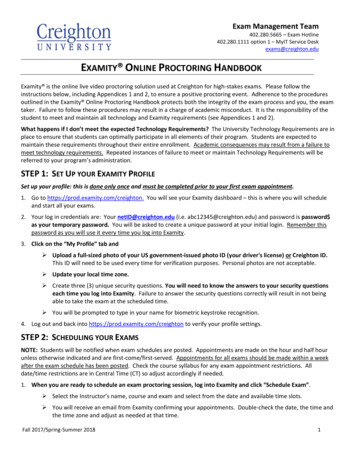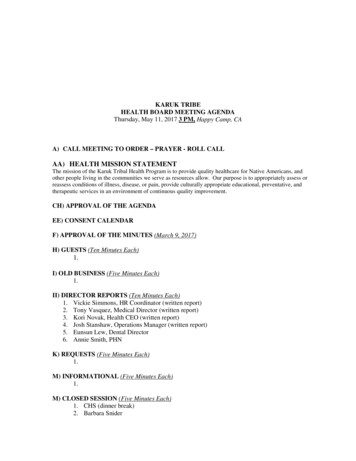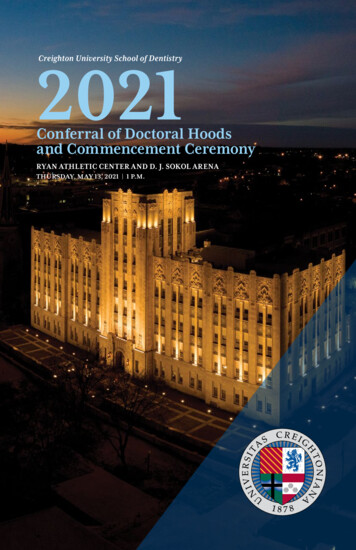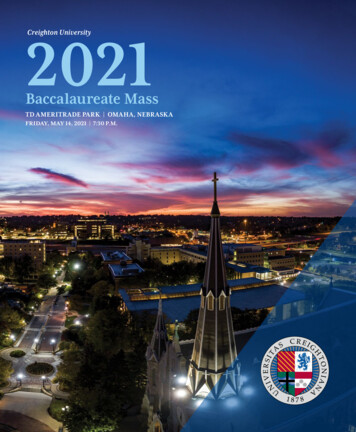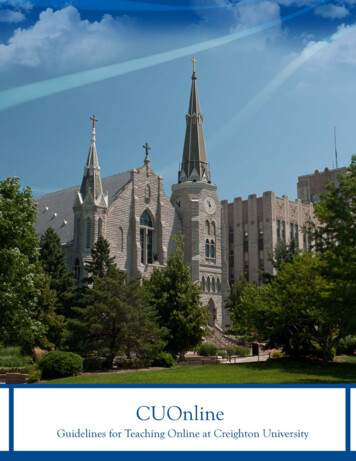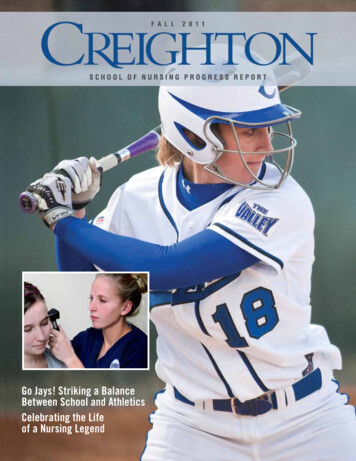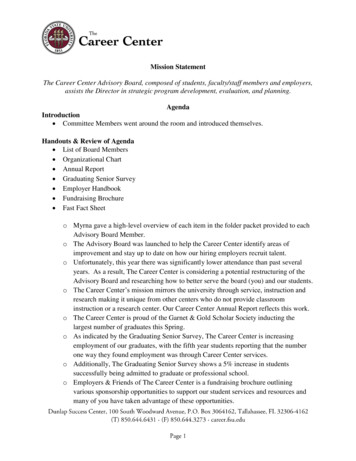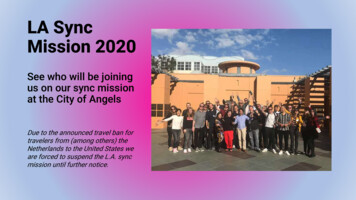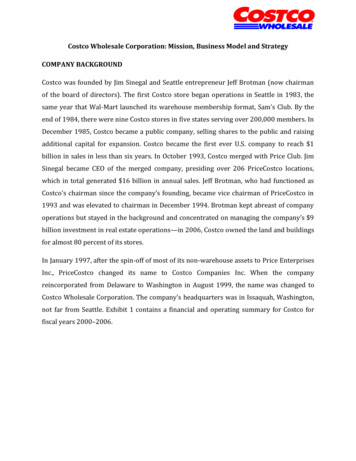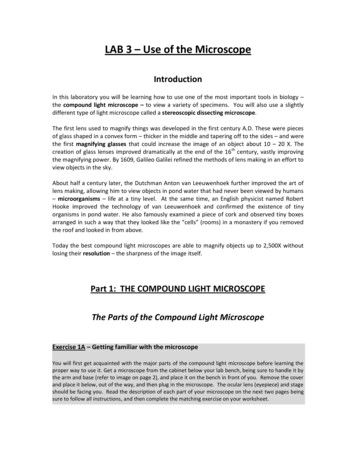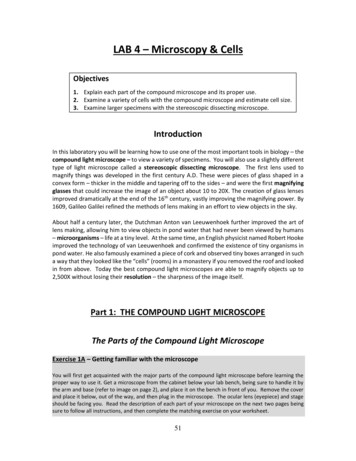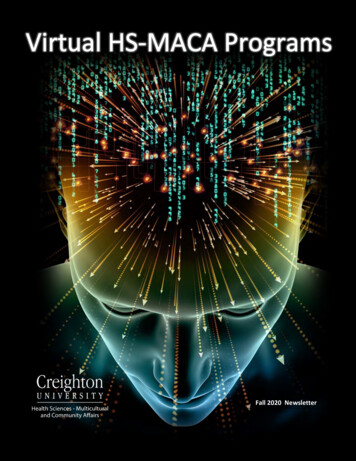
Transcription
Fall 2020 Newsletter1
MISSIONThe mission of Health Sciences Multicultural and Community Affairs is to promote CreightonUniversity as a recognized leader in the training and development of a multicultural health careworkforce that serves to reduce health disparities in underserved and diverse communitiesthrough research, culturally proficient education, community interaction and engagementsthrough Ignatian values.VISIONHealth Sciences Multicultural and Community Affairs will be recognized and respected as aninnovative department that pioneers and synthesizes community, education, research and thedevelopment of future healthcare professionals who are culturally aware and work toward theelimination of health disparities.2
REFLECTIONYear 2020 has been a particularly difficult year for many of us.With the Pandemic COVID-19, it is a year like no other in ourlifetime. We remember our loved ones who have not survivedthe pandemic and we also remember many who survived buthave suffered economically and socially from it. Our campus hasalso experienced big changes, from wearing masks everywhereto social distancing and online classes. Through it all, we havemanaged to make the best of the situation by delivering thequality education that our students expect.In the spring of 2020, our Center for Promoting Health andHealth Equity (CPHHE), an affiliate of HS-MACA, was the proudrecipient of a 250,000 COVID-19 grant from Douglas CountyHealth Department (DCHD) through the CARES Act CoronavirusSade Kosoko-Lasaki, MD, MSPH,relief fund, for 6 months, to address the disproportionately highMBA, FAASSnumbers of morbidity and mortality due to the COVID-19Associate Vice Provost, Health SciencesDirector, Post Baccalaureate/pandemic in the minority community in Omaha. Currently, wePre-Matriculation Programshave educated and trainedProfessor, Ophthalmology(usingthetrain-the-trainermethod) over forty (40) layCommunity Heath Ambassadors/Advocates (CHAs) in the AfricanAmerican churches, the low-income Omaha Housing Authoritytowers, the Latino community and the Maya community in the city.These individuals are helping to spread the CDC recommendationmessaging to their community to reduce the spread of the COVIDCenter for Promoting Healthand Health Equity, CPHHE19 virus.COVID-19 Project LogoThanksgiving cannot come any sooner because we all have a lotto be thankful for. If you cannot interact with loved ones in the usual face-to-face manner, I hopeyou will remember to call, email or video conference. We thank everyone, students and staff thathave had to adjust and follow CDC guidelines of wearing masks, social distancing, washing handswith soap and water and carrying hand sanitizers everywhere. This has kept us safer on campus.As we come to the end of the Fall Semester and look forward to the Holiday Season, we wish youall a Merry Christmas and a very Happy New Year! Remember to remain safe!“He who has health has hope, and he who has hope has everything.” – Arabian proverbSade Kosoko-Lasaki, MD, MSPH, MBA, FAASSAssociate Vice Provost and Professor3
EXECUTIVE ASSISTANT REFLECTS ON VIRTUALCOMMUNICATION AND TASKSby Phebe Mercado Jungman, BS, Administrative Assistant IIICOVID-19 pandemic has brought us all a new normal. This affects everything that we do,everywhere, including our job at HS-MACA. The availability of the internet supported overcomingof COVID-19 barriers that keep us frombeing physically present at the officeand from each other, during thisdifficult time. In performing ourrespective tasks, we use variety ofcommunication strategies. It allows us,despite being separated by geographyand time zones, to work collaborativelyusing the Internet and other media forcommunication.This reflectionspecificallyfocusesontheAdministrative Assistant’s personalexperiences and observations on howPhebe Jungman, BS, HS-MACA AdministrativeSpecialistto explore the opportunities around methat is dressed in something called “work”.In early 2020, working from home was a challenge at first. One of my responsibilities is tocoordinate with staff, faculty, and other stakeholders in various offices, programs, and activitiesto assist the Associate Vice Provost. I need to be able to connect with them and stay informedand updated in their programmatic activities. With mandated work-from-home policies, physicallyvisiting their offices to see and talk to them personally was off the table. I needed to use myfingertips in communicating virtually. This was a challenge for me as directly talking to peopleand coordinating with them in person has always been the best quick way. Following up andfollowing through is another big focus of conducting administrative support virtually. I had tomake sure that I am understood, when communicating required tasks, and that action byresponsible parties is taken and received just in time, with expected accuracy and efficiency. Thekey is good communication and making sure that everything is done right and on time.In the last three months, when the Creighton University reopened campus, going back to workphysically was another challenge to defeat. Having been used to working from the comfort ofmy home, transitioning back to the reality of the workplace became another new normal to adaptto. The use of emails and phones became the media of communicating and the Internet becamea very important resource for most of my questions and concerns. I realized that being adaptableto any situation and making the most of it, always makes sense. However, being able tocommunicate well by using whatever available media there is, and getting my messages across,enabled me to reach out. In reaching out, I can get things done.4
VIRTUAL RECRUITMENT AND RETENTION:PROCESS AND INNOVATIONby Mervin D. Vasser, MPA, Assistant Director, Recruitment and RetentionHandshake LogoWhile majority of colleges and universities around the world integrate some form of onlineeducation into their coursework, moving all aspects of business online may prove to bechallenging. The severity of COVID-19 directly affected the travel industry therefore hinderingany recruitment that requires travel or face-to-face contact. Recruiting efforts are remote andimplemented through various digital platforms.Online events provide an opportunity for students to familiarize themselves with HS-MACA,however, increasing reliance of virtual recruiting has created opportunities and challenges for HSMACA and the students served though programming. Online recruiting is more cost effective andallows for a broader reach of students within a short period of time. Although virtual recruitingprovides more student access, it requires technological know-how.Presenting at colleges and universities, attending graduate and professional career fairs and othernetworking events are key components of HS-MACA’s recruitment strategy. Now it is equallyimportant to conceive of ways to replicate the success of those events virtually. Choosing theright digital platform to host and promote programs and events is essential. Conferencingsoftware like Zoom and Handshake have become very popular and are heavily relied upon bycolleges and universities for their videoconferencing and marketing capabilities.5
HS-MACA’s programs and events are promoted across all social media platforms and digitaldatabases. Everything from the HS-MACA website to its Facebook pages which has reached over4,000 people. Online communities like Pre-Med Star and the American Association of MedicalColleges (AAMC) Minority Applicant Registry (Med-Mar) help target marketing efforts toprospective students. Additional associations like the Association of American Indian Physicians(AAIP) and American Dental Education Association (ADEA), aid in the ability to gain access to avirtual database of over 3,000 students.Virtualrecruitmenthaschallenged the efficacy ofrecruiting efforts. While metricstracking the number of studentsimpacted,enrollment,andattendees help to calculateconversion rates, measures forretaining students are mostindicative of academic success.Academic success, scholarshipsand social support are keyfactors that promote retention.The health and safety ofstudents is the primary concern.Michael Brown, BS, Post-Bac Pre-Medical ProgramInnovative strategies have beenimplemented to create aninclusive environment amid this COVID 19 pandemic.Despite transitioning into a virtualenvironment, opportunities to join clubs, conduct research, participate in clinical simulations andengage in extracurricular activities are available by means of virtually reality techniques. Facultyand staff have continued to provide support while adhering to HS-MACA interdepartmentalpolicies and Creighton University’s COVID-19 Community Standards. Examples include scheduledmeetings with students in the conference room to ensure safe social distancing, no longergathering in large groups, positive, affirming and encouraging e-mails or direct messages tostudents, check-up on students by phone and email virtual birthday celebrations and individual/group mentoring via Zoom.HS-MACA is best positioned to reap the benefits of recruiting and retaining students in a virtualenvironment. The future of healthcare lies in working together with technology and togetherwith healthcare workers must embrace emerging healthcare technologies in order to stay relevantin the coming years.6
VIRTUAL ON-BOARDING OFPOST-BACCALAUREATE STUDENTS AND ORIENTATIONby Larissa Sanon, Post-Baccalaureate CoordinatorPost-baccalaureate students in a virtual classroomIn March, amid the application reviews for the 2020-2021 Post-baccalaureate class, interviewsand selections, the entire world shut down due to the COVID-19 Global Pandemic. The Universityafforded us the opportunity to work from home. Thus, the program had to pivot from physical inperson classes to virtual programming. The many virtual tools utilized for virtual programmingare, BlueLine/Canvas, Adobe, Zoom, Microsoft Office and Outlook, and the GroupMe messagingapp.The Post-baccalaureate program, for as long as it's been in existence, has always been structuredto be a physical in-person learning program, here at Creighton University. Pivoting, for us, meantturning the entire program virtual, where courses and all programming are facilitated viaBlueLine/Canvas. A Department that majorly helped with this transition was the Teaching andLearning Center (TLC), specifically Andrew Bunton, who was so instrumental in guiding the postbaccalaureate staff and faculty in matters relating to virtual learning. All post-baccalaureatecourses were converted into online courses, and training was offered for all post-baccalaureate7
faculty who had no experience teaching online courses. We also made use of the BlueLine/Canvassite, as this is where all the course information was now housed (i.e. all syllabi, grades, coursecontent and communication). Microsoft Outlook also played a huge part, as communication wasimportant, as evidenced by how frequently we emailed each other throughout this transition. Wealso utilized Zoom to keep a sense of visibility and connection with our students, faculty, andstaff.Implementation of virtual post-baccalaureate programming included, looking at the spectrum ofour courses and every aspect of the Post-baccalaureate program, and then planning to transitionall these elements into virtual formats.The first step was contacting the TLC to ensure all courses were now virtual and had onlinecomponents, on which students had access to online discussion boards, and the ability to accesscourse contents, materials and grades. BlueLine/Canvas is Creighton University’s preferred onlinelearning tool. Students were then registered via the Registrar’s Office. Once students wereregistered, all further communication occurred through their Creighton outlook email.Examples of an onboarding task list: Send out Information letter to incoming studentsVerify new students Financial Aid offersCollect Faculty syllabus for diagnostic & pre-matriculation sessionsEmail and Zoom Communication with the new studentsSummer classes registration in collaboration with the registrar’s officePre-Medical and Pre-Dental cohort ScheduleUpdating and disseminating Student handbookCoordinate Online Student orientationCoordinate faculty planning sessionStudents exiting the programCoordinate and presenting data on Spring Course evaluations (faculty Student)Spring course and Faculty evaluationsSend out Faculty communication and planning sessionPre-Matric sessions Course evaluations (faculty student)Complete Certificate applicationsCoordinate Zoom award and recognition ceremonyThe delivery of education via an online environment was a new experience for the Postbaccalaureate program, its instructors, and staff. Through our course and program evaluations,we found valuable information and insight into the impact of virtual learning on students, primaryareas of concern, and opportunities for improvement.8
Students were impacted in both positive and negative ways by their experiences with virtual postbaccalaureate programming. Some students became more responsible and in control of theirlearning atmosphere. Other students recognized the need to be both self-disciplined andmotivated to experience success as online learners. Management issues (e.g., late start dates,late delivery of textbooks and supplemental materials, and issues with systemic support) had anegative impact on the student learning process and diminished the opportunity for students toexperience online learning at an optimal level. The Technological barriers for students and staff,along with skills of online instructors, adaptation of online courses, and accountability, were alsoevaluated. It became clear that a clearly articulated process for overseeing day-to-daycoordination of the program is necessary to ensure its success.The lessons learnt are that we learn from our own project/events experiences as well as theexperiences of others. Sharing lessons learned among team members prevents an organizationor program from repeating the same mistakes and allows them to take advantage oforganizational best practices. Learning should be deliberate. As a department, we should beprepared to take advantage of the key learning opportunities that projects/events provide.To maximize learning from project to project or events, programs should have an infrastructurein place to acquire and socialize project information—lessons learned process. The purpose of alessons learned process is to define the activities required to successfully capture and applylessons learned. As far as plans for future virtual programming we plan to implement a quicksurvey at the end of each virtual event/ meeting to ensure the qualitative impact of each projector event.2020 became a year of firsts for this program, however we’ve managed to navigate the high andlows of learning and implementing programming virtually successfully.9Post-baccalaureate students in class (front to back): Paola Olivares-Carzoli, Julie Nguyen, Brianna Wright and Tina Dinh
OUR VIRTUAL EXPERIENCE IN THIS YEAR’SPOST-BACCALAUREATE PROGRAMby Adnan Almazloum and Brianna Wright, Post-Baccalaureate Student LeadersWhile the excitement of being accepted into the HS-MACAprogram began to settle, we knew that the challenges wewould face ahead would be no easy feat. In addition toentering a program that is known for great academic rigor,we were also preparing to virtually take on every aspect ofour post-bac experience. In summer 2020, the program'sdiagnostic summer session was taught 100% online,challenging us to think more critically while offering usopportunities to learn uniquely. Use of Google Docs andcloud technology, flexible office hours of professors, andgroup study sessions via Zoom were all key infrastructuresthat facilitated our first semester's success in the program.As we approached thefallsemester,thetransition to on-campusclasses in Omaha was aneven greater challenge. Although we would be able toengage in in-person learning, it was also our responsibility toadhere to social distancing rules and the guidelines ofCreighton University. Currently, we have a hybrid of classestaught through Zoom and in-person, allowing a space for usto continue learning during these trying times. While goingback to normal academic environment seems far-fetched inour academic career, we can rest assured that we havepersevered through some of the most challenging times inhistory and can use these lessons to fuel our confidence aswe move forward.Brianna Wright, MS, Fall ClassLeader, Post-Bac Pre-DentalProgramAdnan Almazloum, BS, Fall ClassLeader, Post-Bac Pre-MedicalUltimately, what made this experience fruitful, are the bondsProgramwe created and the sharing of experiences. At HS-MACA, oursuccess stems from our family-like organizational and studentculture. Collectively, we were able to navigate through our curriculum and achieve success.10
THE VIRTUAL SOCIAL INTERACTIONS OF STUDENTS:POST-BACCALAUREATE PROGRAMby Tina Dinh and Erik Steinberger, Post-Baccalaureate Student LeadersWhen the COVID-19 pandemic hit the United States, theenforcement of social distancing guidelines became vital topreventing the spread of disease. Academic institutions such asCreighton University needed to adapt and make big changes tokeep its students and faculty safe. Although the postbaccalaureate program at Creighton University is a relativelysmall program on campus with fourteen students matriculating in2020, returning to campus posed an additional challenge, as mosteach week is spent together.While the campus prepared for safe reopening in the Fallsemester, we began in the post baccalaureate program with anonline summer session. During this period, students remained athome - many still living in states other than Nebraska - andTina Dinh, BS, Spring ClassLeader, Post-Bac Pre-Dentalparticipated in courses through Zoom. When campus reopenedProgramin the Fall, students, faculty, staff, and visitors were required toabide by the university’s COVID-19 Community Standards withdaily temperature checks and #CampusClear screenings,mask requirements, and social distancing guidelines. Withmany professors still teaching remotely and students largelyhaving to remain isolated outside of class, staying connectedwith each other became more crucial than ever.Erik Steinberger, BS, Spring ClassLeader, Post-Bac Pre-MedicalProgramSocial distancing may help flatten the curve and slow thespread of COVID-19, but it also poses a barrier against ourfundamental need for connection. Ironically, the very toolsand devices once blamed for hindering social relationships arenow what keep us together. FaceTime, Skype, Zoom, andother similar platforms which were primarily used for teachingor running meetings, are now being used to spend time withfriends and family. Digital media has kept us sociallyconnected while also remaining physically apart.Students in the Post-Bac program found that even thesmallest of activities integrated into the video chat sessionswere enough in creating meaningful interactions. Theseactivities included anything from virtual games and mini ice breakers, to meal prepping andwatching movies. Students are even finding ways to replicate daily activities. For instance, being11
present on video chat while doing homework silently has proven to be helpful in keeping somestudents on task and accountable for their own academic success.Fewer in-person interactions have also led to the use of various social media apps like Facebook,Instagram, Snapchat, as well as group chats on Messenger, iMessage, and GroupMe for classcommunication. Students are very involved in these forums, bidding their classmates goodmorning and good night, sending memes and GIFs, holiday greetings, and of course, “HappyStudying!” As the nation prepares for a second wave of COVID-19, students in the Post-Bacprogram will continue to a
to be a physical in-person learning program, here at Creighton University. Pivoting, for us, meant turning the entire program virtual, where courses and all programming are facilitated via BlueLine/Canvas. A Department that
